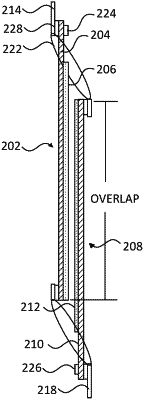| CPC A41D 1/002 (2013.01) [H02N 13/00 (2013.01); A41D 2400/38 (2013.01)] | 20 Claims |

|
1. A wearable article, comprising:
a textile configured to be worn by a wearer; and
an electroadhesive clutch secured the textile and comprising:
a first electrode assembly comprising a first conductive member;
a second electrode assembly comprising a second conductive member overlaying in part the first conductive member;
an elastic encasing within which the first and second electrode assemblies are positioned, the elastic encasing forming a first bond with the first conductive member at a first location of the elastic encasing and a second bond with the second conductive member proximate a second location of the elastic encasing different than the first location; and
an electrical signal generator configured to provide first and second signals to the first and second conductive members of the first and second electrode assemblies, respectively, wherein the first electrode assembly is configured to slide laterally relative to the second electrode assembly when the first and second signals are not applied and remain static relative to the second electrode assembly when the first and second signals are applied;
wherein the electroadhesive clutch is configured to inhibit increasing a size of an opening when the first and second signals are applied to the first and second electrode assemblies and wherein the opening is enabled to increase in size when the first and second signals are not applied.
|